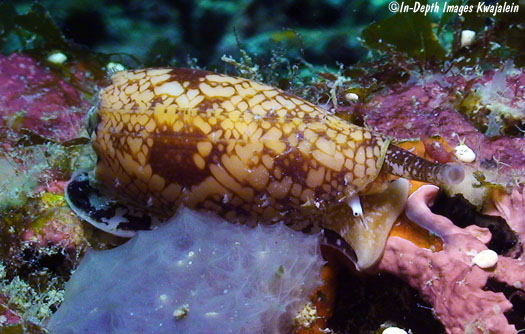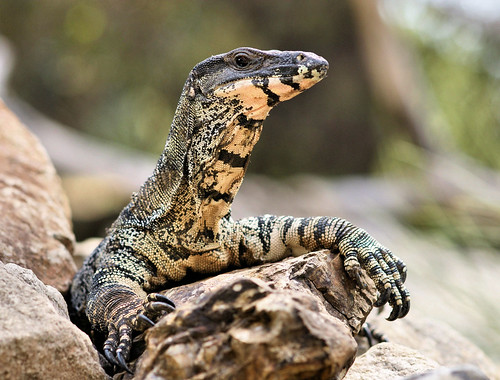|
|
Post by Reticulatus on Mar 18, 2014 6:56:11 GMT 5
Geography Cone 
Gastridium geographus, common name the geography cone, is a species of predatory sea snail, a marine gastropod mollusk in the family Conidae, the cone snails, cone shells or cones. Although all cone snails hunt and kill prey using venom, the venom of this species is known to be especially potent. Live cone snails of this species should not be handled or only handled with extreme caution, because they will sting humans, sometimes with serious results.
Gastridium geographus has a broad, thin shell, cylindrically inflated. Geography cones grow to about 4 inches (10 cm) to 6 inches (15 cm) in length. The size of an adult shell varies between 43 mm and 166 mm. The ground color of the shell is pink or violaceous white, occasionally reddish. It has a mottled appearance, clouded and coarsely reticulated with chestnut or chocolate, usually forming two very irregular bands. This intricately brown-and-white pattern is highly prized by shell collectors.
The geography cone has a wide, violaceous white or pink aperture and numerous shoulder ridges or spines. The shell is covered with thread-like revolving striae, usually nearly obsolete except at the base. The flattened spire is striated and coronated.
In comparison with other species, the shell has a noticeably wider and convex mid-body, with a flattened spire. Its walls are also noticeably thinner and lighter compared to other cone shells of similar length and size.
Geography cones are common. They occur in the Red Sea, in the Indian Ocean along Chagos, Madagascar, Mauritius, Mozambique and Tanzania. They are indigenous to the reefs of the Indo-Pacific region, except for Hawaii.
Gastridium geographus is highly dangerous - live specimens should be handled with extreme caution. Gastridium geographus has the most toxic sting known among Conus species and is responsible for more than thirty human fatalities. Their venom, a complex of hundreds of different toxins, is delivered through a harpoon-like tooth propelled from an extendable proboscis. There is no antivenom for a cone snail sting, and treatment is limited to merely keeping victims alive until the toxins wear off.
Among the compounds found in cone snail venom are proteins which, when isolated, have great potential as pain-killing drugs. Research shows that certain of these proteins target specific human pain receptors and can be up to 10,000 times more potent than morphine without morphine's addictive properties and side-effects.
Conantokin-G is a toxin derived from the venom of Conus geographus.
Greater Blue-Ringed Octopus 
The greater blue-ringed octopus (Hapalochlaena lunulata) is one of three (or perhaps four) species of venomous blue-ringed octopuses. Unlike its southern brethren, the Blue-lined and Southern Blue-ringed octopuses that are found only in Australian waters, the range of the greater blue-ringed octopus spans the tropical western Pacific Ocean. Greater blue-ringed octopuses can weigh between 10 and 100 grams depending on age.
The greater blue-ringed octopus eats mostly crustaceans such as crabs and shrimp. Also, it eats coral reef fish that stray too close by. It injects them with a powerful neurotoxin that easily paralyzes them, which allows the octopus to devour its prey.
Their venom (a poisonous saliva), which includes a neurotoxin known as tetrodotoxin, is produced by bacteria in the salivary glands. Tetrodotoxin blocks sodium channels, causing motor paralysis and respiratory arrest within minutes of exposure, leading to cardiac arrest due to a lack of oxygen.
|
|
|
|
Post by Venomous Dragon on Mar 18, 2014 7:02:12 GMT 5
I really don't know
|
|
fish
Junior Member Rank 1
 Spaced-out Hatchetfish
Spaced-out Hatchetfish
Posts: 45
|
Post by fish on Mar 18, 2014 7:28:58 GMT 5
What a strangely awesome matchup. Not many matches featuring non-arthropod and non-cephalopod invertebrates. off the top of my head I'd say the octopus on account of its relative agility and ability to grasp the snail from the top or behind and inject a quick acting venom; not completely sure if the octopus could pierce the shell, although they do eat smaller shelled prey. A quick read on wikipedia says the snail shoots its venom from the front by the proboscis so it may find it hard to position itself if the octo acts quick. I could be completely wrong and am too lazy to do research here, so Retic or anyone else if you want to educate me on these cone snails, be my guest.
|
|
|
|
Post by Reticulatus on Mar 18, 2014 8:31:16 GMT 5
The snail can actually fire its radula from its proboscis at almost any angle, that's why there is really no safe way to pick these creatures up. The snail could even reach over its shell and attack, I saw a video on the topic once I'll see if I can find it.
|
|
|
|
Post by Reticulatus on Mar 18, 2014 8:54:34 GMT 5
this isn't the video but its still relevant.
|
|
|
|
Post by Reticulatus on Mar 18, 2014 9:13:00 GMT 5
|
|
|
|
Post by Vodmeister on Mar 18, 2014 11:23:21 GMT 5
How large are these two animals (compared to each other)?
If they are equal in weight, I side with the octopus. They can be quite formidable wrestlers for their mass.
|
|
|
|
Post by creature386 on Mar 18, 2014 17:43:23 GMT 5
Doesn't the cone snail have some kind of range advantage because it can "fire" it's tongue? Also, it's venom takes some minutes to kill someone. As the octopus would very likely quickly show signs of paralyzation, I favor the snail.
This battle between two of the most venomous animals we have is pretty fascinating though.
|
|
|
|
Post by Reticulatus on Mar 18, 2014 18:23:29 GMT 5
The octopus may be up to 8 inches on the top end, but that's legs and mantle. The snail maxes out at 5 inches for the shell, the proboscis is also at least that long.
|
|
|
|
Post by Vodmeister on Mar 18, 2014 20:41:06 GMT 5
The octopus may be up to 8 inches on the top end, but that's legs and mantle. The snail maxes out at 5 inches for the shell, the proboscis is also at least that long. In that case the snail will win, it's probably significantly heavier than the octopus. |
|
|
|
Post by creature386 on Mar 18, 2014 21:28:10 GMT 5
I don't think weight is that important in a fight between two animals which have the venom to kill a human.
|
|
fish
Junior Member Rank 1
 Spaced-out Hatchetfish
Spaced-out Hatchetfish
Posts: 45
|
Post by fish on Mar 19, 2014 4:21:31 GMT 5
The snail can actually fire its radula from its proboscis at almost any angle, that's why there is really no safe way to pick these creatures up. The snail could even reach over its shell and attack, I saw a video on the topic once I'll see if I can find it. Well if thats the case, maybe the snail would be the favorite then, I dont really know. Even if the octopus can surprise the snail from the top of the shell, I dont know if its beak is powerful enough to pierce he shell so it can inject its venom. I do wonder, if the octopus just straight out attacked the snail and they both injected each other, whos venom is stronger and who would die first? Mutual destruction in the long term, but whoever can hold on for the few moments longer "wins" lol. |
|
|
|
Post by creature386 on Apr 28, 2014 23:36:28 GMT 5
www.youtube.com/watch?v=OK2t3sffkrEJudging from this video, the geography cone's venom literally gives you enough time for one more smoke, before you start with the agony. Looks like we have a clear winner.
|
|
|
|
Post by An Goldish Jade on Mar 1, 2016 13:56:35 GMT 5
Is it possible for Octopus to inflict damage to the Cone Shell without been bitten? lower then vice versa is what I believe.
|
|
|
|
Post by creature386 on Mar 1, 2016 14:35:56 GMT 5
I guess if the starting distance of the fight is low and the octopus acts quickly, it is possible. I agree that its odds to do so are not high.
|
|














